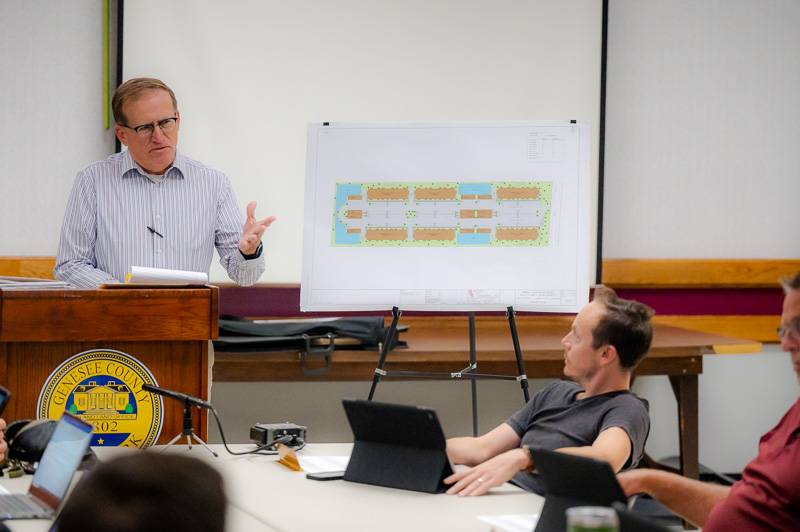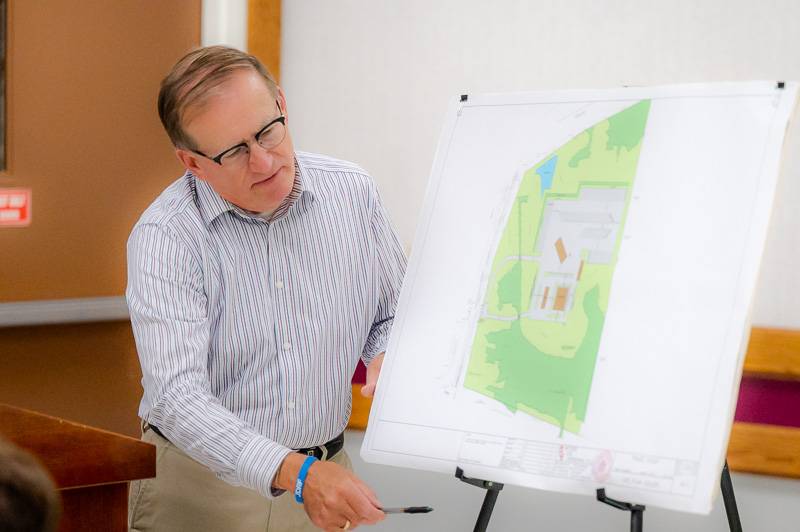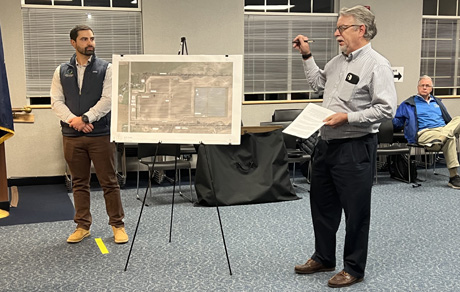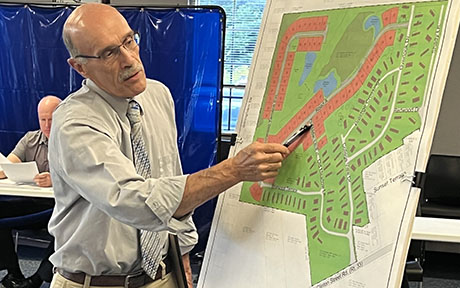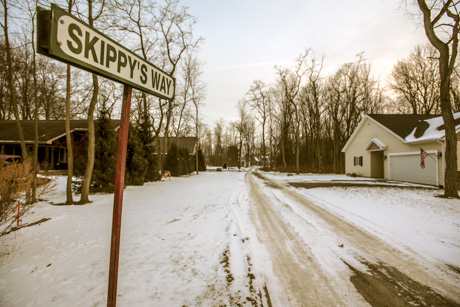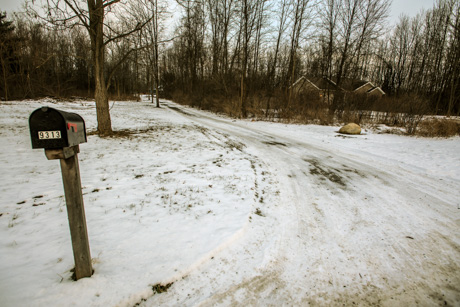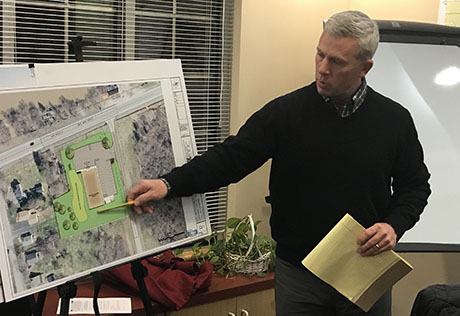Good fences make good neighbors the poet Robert Frost observed, but that may not apply to driveways, at least not in Le Roy.
A driveway is the latest flashpoint in a nearly decade-long neighborhood dispute that pits local businessman Pete McQuillen against Steve Barbeau and other residents of the subdivision known as Presidential Acres.
In the latest chapter, McQuillen was brought up on criminal charges for use of a driveway that traverses a parcel he owns next to the residence of Barbeau. It allows him to access both a utility building he constructed behind Barbeau's lot and the single-family home he and his wife, Judith, now live in further back on their parcel.
A judge in Darien Town Court dismissed the criminal complaint, which prompted Barbeau and several other residents to file an Artice 78 petition seeking, among other things, to overturn the dismissal.
An Article 78 filing, or proceeding, is an appeal of an agency decision. It is how a citizen in New York can appeal to judge in a county supreme court the ruling or decision of any government agency in the state.
Barbeau's side lost in a harshly worded decision written by Justice Emilio Colaiacovo of the NYS Supreme Court 8th Judicial District.
"As this Court has some familiarity with these parties and prior proceedings, it is deeply troubled by the continued methods employed by the Petitioners," Colaiacovo wrote. "While it is one thing to complain about your neighbor, it is another to install video equipment and keep a log documenting your neighbor's activities in an attempt to subject and expose him to criminal prosecution. The Petitioners' demonstrated pattern of prosecution against their neighbor is nothing short of harassment."
Despite the ruling, the legal proceedings are likely to continue, Barbeau indicted in an email to The Batavian.
History of Disputes
McQuillen purchased property in the Fillmore/Robbins Road area, adjoining Presidential Acres, in September 2010.
Shortly after acquiring the property, McQuillen announced his intention to build 26 single-family homes for people 55 and over on the subdivision, which McQuillen dubbed "Robbins Nest." This met with opposition and eventually resulted in a lawsuit with Barbeau, supervisor in the Town of Le Roy, as one of the plaintiffs.
The legal challenges eventually brought an end to McQuillen's plans for Robbins Nest, but by that time he was being sued over duplexes he built in the subdivision as well as a challenge to the utility barn he built behind Barbeau's home.
McQuillen eventually prevailed in the challenge to the duplexes and in that ruling, issued in February 2017, Colaiacovo determined the challenge to the utility structure was moot because McQuillen had built a single-family residence on the property (a utility structure, or garage, or barn, is not permitted as a stand-alone structure on a lot in a single-family area, according to Village of Le Roy code).
Village code enforcement had, perhaps incorrectly, issued a building permit to McQuillen for the utility building before plans were submitted for the single-family residence.
While McQuillen was erecting that barn-like structure in August 2013, Barbeau became upset with McQuillen when a tree fell on his house (there was little or no damage). An argument ensued and an accusation that Barbeau shoved McQuillen, causing him to fall ot the ground, leading to Barbeau's arrest (Barbeau eventually received a conditional discharge).
It was during this time that Barbeau and his then-neighbor David Boyce (who has since moved) had their own complaints against McQuillen. McQuillen was accused of parking construction equipment in front of their homes; storing waste construction material on the property across the street; and of once dumping a pile of manure against the back property line Boyce's home just in time for a graduation party for Boyce's daughter (an allegation recounted in a recent email to The Batavian from Amy Kendall, attorney for the Presidential Acres residents).
In July 2013, the Village granted a building permit for McQuillen to construct a single-family home with an address of 9313 Robbins Road.
Boyce and neighbors, in a lawsuit titled Bartz vs. Le Roy, challenged the ZBA's decision on the building permit.
As part of its decision, the ZBA ruled (and this point is part of the ongoing dispute) that ingress and egress for 9312 Robbins Road would be from a driveway leading to Robbins Road.
The neighbors ended up withdrawing the suit, letting the ZBA decision stand, in order to challenge McQuillen's use of the driveway leading to Fillmore Street.
Barbeau began keeping a log of traffic on that driveway, and at the suggestion of a code enforcement officer, set up a video camera to monitor vehicle traffic on the driveway.
That evidence was eventually used to file a criminal complaint against McQuillen. The case was moved to Darien because both justices in Le Roy had a conflict of interest as did Judge Gary Graber in Darien, which is how the case was handed to Darien Town Justice Michelle Krzemien.
The Easement
Pete and Judith McQuillen own the parcel at 9313 Robbins Road.
Judith McQuillen is CEO of Circular Hill Inc., according to a court filing by attorney Kendall, and that corporation owns the parcel adjoining Fillmore Street.
In September 2013, Circular Hill granted an easement to the McQuillens for use of a driveway and utility connections attached to the Robbins Road residence.
In July 2014, the Zoning Board of Appeals affirmed its prior decision to issue a building permit, after hearing an appeal from the neighbors, and stated in its decision, "The board notes the owners' right of entry to the primary and accessory structure will be accessed through Robbins Road."
It's the position of Barbeau and his co-plaintiffs that the decision limits the McQuillens to using only the drive leading to Robbins Road.
One point of contention in the case is that McQuillen did not mention, nor did the ZBA ask about, nor did anybody apparently research, the easement on the property next to Barbeau's.
McQuillen did not appeal this decision and later claimed he did not know about the ZBA's written decision requiring access on Robbins Road.
The McQuillens received a certificate of occupancy for their new home in June 2016.
Later that month, Pete McQuillen testified in the Bartz case that he used the Robbins Road driveway for ingress and egress to his house.
In July 2016, Code Enforcement Officer Jeff Steinbrenner sent a letter to McQuillen notifying him that he was violating Village code and the ZBA decision by using the Fillmore Street driveway.
From August 2016 through January 2017, Barbeau made a log of vehicles using the Fillmore Street driveway, which included a black Dodge Ram, a white GMC SUV, a gray pickup, a FedEx truck, tractors, a four-wheeler, and several other vehicles.
The following February, the Village filed a criminal complaint against McQuillen.
The case was transferred to Darien Town Court in May and McQuillen's attorney Benjaman Bonarigo filed a motion to dismiss the criminal complaint "in the interest of justice" in the fall.
A hearing on the motion was held Dec. 3, 2017.
The Dismissal Hearing
In New York, a criminal case can be dismissed "in the interest of justice" if a judge finds compelling factors about the circumstances of the case that clearly demonstrate that prosecution, or conviction, would result in an injustice, such as insufficiency of evidence or the defendant was really doing nothing wrong.
At the dismissal hearing in People v. McQuillen, Bonarigo represented McQuillen and James Wujcik represented the Village of Le Roy.
Kendall and Barbeau were also present and both attempted to speak and Krzemien denied their requests, an effort characterized by Colaiacovo in his ruling as an attempt to influence the proceedings.
In her subsequent filings, Kendall would have a few complaints about this hearing:
- That neither Bonarigo nor Wujcik corrected Krzemien on relevant points of law;
- That Wujcik did not correct what Kendall sees as inaccurate factual statements during the hearing and that he did not sufficiently challenge Bonarigo on points of law;
- That neither attorney corrected Krzemien on misstatements about the county issuing the easement;
- That Bonarigo failed to produce citations to back his assertion that the easement barred his client from being charged criminally;
- That she wasn't allowed to speak in violation of court rules.
At the hearing, Bonarigo spoke first, according to a court transcript, and presented the facts of the case as he saw it, from McQuillen's purchase of the property in 2010 through McQuillen's eventual criminal charge. He covered the easement and the ZBA hearings.
In the midst of his presentation, Krzemien interrupted and explained why she had not read filings from Kendall relevant to the Bartz case.
"I did not look at the paperwork because I don't know too much about zoning and you (Bonarigo) told me the appellate -- the appellate decision had nothing do with what was laid out here," she said.
A short time later, Bonarigo sums up, "Let me just say ... there's an easement. It's a matter of record. It allows for exactly what Mr. McQuillen is accused of doing here in a quasi-criminal matter. Therefore, it's our contention that based upon those facts and what's before this court, documentarily, that you should dismiss this case in the interest of justice."
In response, Wujcik argues that the ZBA had already ruled that McQuillen could only access his property from Robbins Road.
"Mr. McQuillen never disclosed that he had an easement," Wucik said. "So since he didn't disclose it, then the business about that he wasn't aware of the ZBA's decision -- our position is that's misplaced because he was the defendant in a litigation, so he certainly was aware of the two -- there's also a different ZBA decision against him -- but he was aware of that."
After more discussion, Krzemien asked who issued an easement, the village or the county.
Wujcik explained that private citizens grant easements, with a short explanation of how the process works, and that once two private parties agree on an easement, it is filed with the relevant government agency.
After the explanation, Krzemien asked, "So I guess what I'm asking is, ... in the VIllage of Le Roy, is there a process that you would go through to get an easement or all easements issued through the county?"
Bonarigo: "No, there is no such procedure."
Krzemien: "No such procedure."
There is then a long discussion related to issues contained in the Bartz case.
Returning to the requirement to use Robbins Road, Bonarigo said, "The ZBA can't create that by law over the top ... they can't take away a legal right that has been formulated for years prior to it by just a stroke of the pen. They don't have that kind of authority. As a matter of law, the easement was in existence."
Wujcik said the ZBA has the authority to nullify an easement, and as to the assertion that the ZBA didn't ask about the easement, "the Zoning Board of Appeals doesn't know what it doesn't know. If they are not made aware of an easement, they can't make an interpretation or a ruling on it."
Bonarigo: "They were made aware of it, Judge. That's my point."
He would later point out that the easement is on file with the clerk's office and is a public document and easily discoverable. In reviewing court documents obtained by The Batavian we didn't find any indication the ZBA was made aware of the easement prior its decision, nor is there any indication any ZBA member or staff member tried to research the title of the property.
After more discussion, Krzemien makes reference to the county granting the easement and discusses the life of the easement, which goes with the land.
Wujcik did not correct her misstatement about the easement being granted by the county but did agree it goes with the land.
Later, Wujcik points out that the McQuillens filed the easement two weeks after the first ZBA discussion of the property but before any ZBA decision.
At this point, Kendall tries to speak and Bonarigo objects.
"This is not a civil matter despite what Ms. Kendall might think," Bonarigo tells the judge.
Krzemien: "Ms. Kendall, I'm sorry. I'm not going to hear what you have to say, so will you have to sit down, please."
A few pages later in the transcript, Krzemien again refers to the county issuing the easement and neither attorney corrects her misstatement.
At one point, Krzemien complains about Kendall, "I'm not. I'm not. I know you're just -- got information from him. And that little bird back there is chirping at you."
Wujcik: "Yeah, I don't need her -- no disrespect to her, I don't need the chirping."
When it comes time to discuss when Krzemien might issue a decision, Krzemien asks that McQuillen, in the meantime, stop driving bulldozers down the driveway, along with snowmobiles and four-wheelers; asking that they only use the driveway for their own personal vehicles, except for snow removal. McQuillen agrees.
On April 16, Krzemien granted McQuillen's motion, dismissing the criminal complaint in the interest of justice, noting the existence of a valid easement.
The Village of Le Roy did not appeal Krzemien's decision, and Wujcik later informed Colaiacovo that the Village would not be joining the challenge by neighbors to the ruling.
The Batavian emailed Wujcik last week and asked why the Village did not appeal the ruling, as well as why Wujcik did not mount a more explicit challenge to Bonarigo's assertion that the easement took precedence over Village code or the ZBA decision. After acknowledging our questions and saying he would respond, he did not provide a statement.
The Batavian also contacted Bonarigo and asked him to provide case law citations or specific code sections that would indicate an easement takes precedence over local codes or a ZBA decision.
Bonarigo responded:
A decision was rendered by Justice Emilio Colaiacovo, Supreme Court, supporting my client's position on the Art. 78. I trust you have read that and would hope that you are going to report that result as I don't care to relitigate the Town of Darien case with you.
Bonarigo has declined to comment on follow-up questions.
Article 78 Petition and Ruling
Kendall filed an Article 78 petition May 16. The petition was on behalf of Barbeau, Earl Bickett, Robert Boyce, Joseph McKay, Stephen Moulton, and Ronald Paganin, all property owners in Presidential Acres.
In her motion, Kendall said the petitioners had no other means of seeking remedy than through an Article 78 petition.
The petition asks the court to annul Krzemien's "arbitrary, capricious, and illegal decision." Kendall claimed the ruling was based on insufficient information and misunderstanding of relevant law. Kendall asked the court to rule the use of the driveway off of Fillmore Street illegal and order that it no longer be used.
She asked that the court rule that the McQuillens' use of the driveway constituted a nuisance.
As part of the motion to overrule Krzemien's decision and bar use of the driveway, Kendall complains that the Village of Le Roy failed to challenge the judge's inaccurate statements and that her clients have experienced special damages.
She also asks for attorneys fees, court costs and punitive damages.
By the third page of his 17-page opinion rendering his decision, Colaiacovo is sniping at the petitioners.
"The petitioners live near McQuillen and have exhaustively and painstakingly monitored this otherwise innocuous activity and complaint to the Village of Le Roy," Colaiacovo writes.
The justice ruled that since the criminal proceeding involved only the Village of Le Roy, which declined to participate in the petition, and McQuillen, the petitioners lacked standing to file the motion.
The petitioners failed to demonstrate any injury or harm they sustained because McQuillen used the driveway, Colaiacovo said, adding, "It certainly is not a nuisance as Petitioners maintain, however, there is mounting evidence to suggest that these continued lawsuits are."
He dismissed the complaint against Krzemien, saying that even if the petitioners had standing, Krzemien has judicial immunity.
"Petitioners insist that they have a viable cause of action against the Town Justice because she lacked subject matter jurisdiction over a ZBA decision. Petitioners strangely maintain that by granting the motion to dismiss, the judge erroneously invalidated a ZBA decision by passing judgment on the validity of an easement. However, the Town Justice insists that these charges were dismissed 'in the interest of justice.' This court agrees that the Petitioners' argument improperly mischaracterizes the decision of the Town Justice."
While a town justice doesn't have subject matter jurisdiction, Colaiacovo said, they can dismiss such matters "in the interest of justice."
"Judge Krzemien's determination was just that, a determination and exercise of her judgment, and not a ministerial or clerical act that could be reviewed under Article 78."
He added later in the same section, "to otherwise entertain the relief requested would create a terrible precedent, allowing officious, meddlesome individuals, like those here, an opportunity to intervene and challenge any judge's decision that offends their belief of what the law should be. Sanctioning the relief requested by the Petitioners would only empower like-minded obstreperous people who are engaged, as is the case here, in a simple yet ongoing neighborhood dispute."
While the neighbors sought attorneys fees, court costs, and punitive damages, Colaiacovo notes the arguments of Bonarigo claim that the Article 78 petition was "frivolous" and that challenging the town justice's decision was "beyond zealous representation and of a client and constituted an abuse of process."
Colaiacovo also faulted Kendall and Barbeau for what he said was attempted interference in the McQuillen case at the Dec. 3 hearing and then commencing the Article 78 petition without standing.
"This tactic, which is completely lacking in merit and cannot be supported by a reasonable argument, cannot now be simply overlooked," Colaiacovo wrote. "When viewed in its entirety, the conduct of Petitioners clearly evidences a systematic and torrid legal assault of anyone who stands in the way of what they ultimately seek, including a local Town Justice. This court finds that this reckless and egregious conduct justifies the imposition of costs and fees."
Colaiacovo ordered a hearing on costs and fees for 9:30 a.m., Feb. 14.
Kendall said her clients remain unsatisfied with the response of the Village to the situation, unhappy with Krzemien's ruling, and with Colaiacovo's opinion upholding that decision.
"My clients simply want the McQuillens to comply with the law of the Village," Kendall wrote in an email to The Batavian. "I do not know why that is so difficult. The McQuillens have at least one other driveway onto their property, so the reason they continue to violate the ZBA Decision seems clear. The Village did not support its Code Enforcement Officer’s determination that McQuillen was violating the ZBA Decision by appealing the Justice Court’s obviously incorrect decision. At this point, it appears that having an easement allows you to violate Village law and that is a very dangerous precedent."
She added, "My clients do not want to live with this ongoing harassment and feel that they should be protected from it by the Village. The Village isn’t protecting them."
Given a chance to respond to Kendall's remarks, McQuillen replied, "My response would be to only quote the Supreme Court Judge Hon. Emilio Colaiacovo in his decision – 'The Petitioners’ demonstrated pattern of prosecution against their neighbor is nothing short of harassment.' "
This is probably not the end of the story.
Previously:
- Town of Le Roy named as defendent in lawsuit by new town supervisor, Jan. 10, 2012
- Planned senior housing project in Le Roy starting over on approval process, May 10, 2012
- Plan for Robbins Nest in Village of Le Roy continues to divide community, Aug. 28, 2012
- Hearing tonight in Le Roy Village Hall to change voting requirement for PUD zoning, Sept. 26, 2012
- Robbins Nest a tangled mess as final approval hangs in the balance, Sept. 27, 2012
- Town of Le Roy supervisor arrested following alleged incident with neighbor, Aug. 12, 2013
- Barbeau and McQuillen feud building for months, Aug. 15, 2013
- Le Roy town supervisor given chance to avoid further prosecution on criminal charges, Sep. 10, 2013
- Residents of Presidential Acres in Le Roy pursuing new suit to stop duplex development, Aug. 11, 2014
- Le Roy mayor takes responsibility for paving of apparently privately owned road, Oct. 16, 2014
- Village of Le Roy will plow privately owned street that is subject of litigation, Dec. 21, 2014
- Plan for 55+ housing in Le Roy may be put back on the table, April 25, 2016
- Judge rules in favor of developer building duplexes in the Village of Le Roy, Feb. 9, 2017
- Appeals court rules a variance required for duplexes in Le Roy's Presidential Acres, March 27, 2018
Photos: Top and bottom photo made Jan. 17. The top photo is the driveway from Fillmore Street. The bottom photo is the driveway from Robbins Road. Both drives showed evidence of regular use at the time the photos were taken. "Skippy's Way" refers to a friend of Pete McQuillen's, he said.
Map of the area we created in 2013 to provide an overview of who owned what property. Fillmore Street now connects with Robbins Road. David Boyce is no longer a resident of Presidential Acres.
